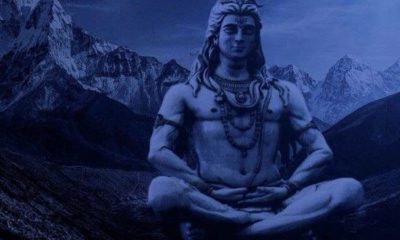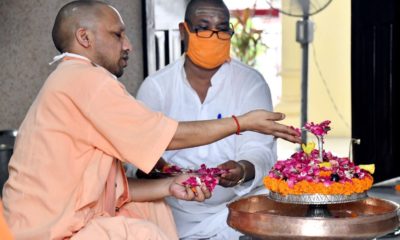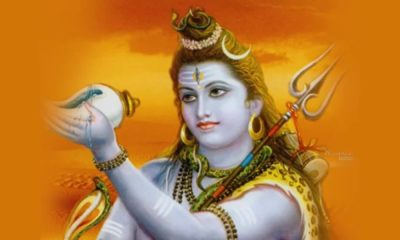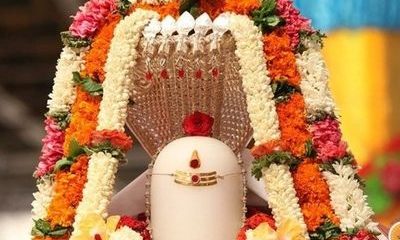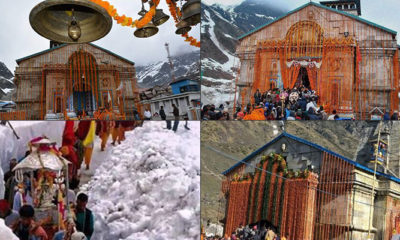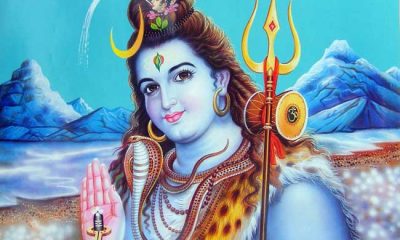Feature
Know why Lord Shiva loves Shravan month

The month of Shravan is dedicated to Shiva. The word Shiva means the destroyer of sin- Shyati Papam. The name Rudra of Shiva is also very popular. Apart from this, Shivji is also called Bhava, Sharva, Pashupati, Ugri, Mahadev and Ishaan. In the Atharvaveda it is also called ‘Neelamsyodram Lohit Pustam’.
Shiva Purana has five functions of Shiva – creation, status, destruction, frost and salvation. Panchmukh is said to be the reason. Every Monday of the month of Shravan is very important. The fast, worship and aarti of Lord Shiva have special significance on Mondays of Shravan month. One should also chant the Shiva Panchakaksha mantra. Actually Monday represents the Moon. The Moon is the lord of the mind. Sits on Shiva’s forehead. ‘Moon Manso Jat:’ means Moon is the master of the mind.
By controlling the moon sitting on Shiva’s head, the devotee is able to free his mind from the illusion of illusion. One becomes free from birth and death. Every year we have seen thousands of kanvadis going to the Ganges River every year, taking the kanvad in Shravan itself. Shiva is pleased to be anointed with the waters of holy rivers. If seen, Shravan is the rainy month.
In this month of coming to Chaturmas, when Shri Hari is sleeping, the saints are guiding the citizens at one place through the story of Narayana, Shiva and other deities. Major festivals such as Hariyali Teej, Rakshabandhan, Nagpanchami are also present in Shravan. In a way, Shravan is the month of conservation of nature. The sea churning was also held in the month of Savan. Hanahal Venom Shankar came out of it and absorbed the throat and protected the world. To reduce the effects of the poison, all the gods and goddesses offered him water.
Offering water to Shiva in the month of Shravan achieves special fruit. It is mentioned in the Shiv Purana that Lord Shiva himself is water. Lord Shankar should be worshiped in the month of Saavan to please his family members especially Ganesha. Rudrabhishek of Shiva has special significance. Rudrabhishek can be done every day, for special benefit. In Rudrabhishek, bath with water, milk, curd, pure ghee, honey, sugar or sugar, Ganga water and sugarcane juice etc. is given.
After the consecration, one should offer Dub, Belpatra, Shamipatra, Aak, Tulsi, Madar, Neelkamal etc., which makes Shiva very happy. Bhang and Dhatura are also very fond of Shiva.
Entertainment
Meghalaya Reserves Legalized Gambling and Sports Betting for Tourists

The State Scores Extra High on Gaming-Friendly Industry Index
Meghalaya scored 92.85 out of 100 possible points in a Gaming Industry Index and proved to be India’s most gaming-friendly state following its recent profound legislation changes over the field allowing land-based and online gaming, including games of chance, under a licensing regime.
The index by the UK India Business Council (UKIBC) uses a scale of 0 to 100 to measure the level of legalisation on gambling and betting achieved by a state based on the scores over a set of seven different games – lottery, horse racing, betting on sports, poker, rummy, casino and fantasy sports
Starting from February last year, Meghalaya became the third state in India’s northeast to legalise gambling and betting after Sikkim and Nagaland. After consultations with the UKIBC, the state proceeded with the adoption of the Meghalaya Regulation of Gaming Act, 2021 and the nullification of the Meghalaya Prevention of Gambling Act, 1970. Subsequently in December, the Meghalaya Regulation of Gaming Rules, 2021 were notified and came into force.
All for the Tourists
The move to legalise and license various forms of offline and online betting and gambling in Meghalaya is aimed at boosting tourism and creating jobs, and altogether raising taxation revenues for the northeastern state. At the same time, the opportunities to bet and gamble legally will be reserved only for tourists and visitors.
“We came out with a Gaming Act and subsequently framed the Regulation of Gaming Rules, 2021. The government will accordingly issue licenses to operate games of skill and chance, both online and offline,” said James P. K. Sangma, Meghalaya State Law and Taxation Minister speaking in the capital city of Shillong. “But the legalized gambling and gaming will only be for tourists and not residents of Meghalaya,” he continued.
To be allowed to play, tourists and people visiting the state for work or business purposes will have to prove their non-resident status by presenting appropriate documents, in a process similar to a bank KYC (Know Your Customer) procedure.
Meghalaya Reaches Out to a Vast Market
With 140 millions of people in India estimated to bet regularly on sports, and a total of 370 million desi bettors around prominent sporting events, as per data from one of the latest reports by Esse N Videri, Meghalaya is set to reach out and take a piece of a vast market.
Estimates on the financial value of India’s sports betting market, combined across all types of offline channels and online sports and cricket predictions and betting platforms, speak about amounts between $130 and $150 billion (roughly between ₹9.7 and ₹11.5 lakh crore).
Andhra Pradesh, Telangana and Delhi are shown to deliver the highest number of bettors and Meghalaya can count on substantial tourists flow from their betting circles. The sports betting communities of Karnataka, Maharashtra, Uttar Pradesh and Haryana are also not to be underestimated.
Among the sports, cricket is most popular, registering 68 percent of the total bet count analyzed by Esse N Videri. Football takes second position with 11 percent of the bets, followed by betting on FIFA at 7 percent and on eCricket at 5 percent. The last position in the Top 5 of popular sports for betting in India is taken by tennis with 3 percent of the bet count.
Local Citizens will Still have Their Teer Betting
Meghalaya residents will still be permitted to participate in teer betting over arrow-shooting results. Teer is a traditional method of gambling, somewhat similar to a lottery draw, and held under the rules of the Meghalaya Regulation of the Game of Arrow Shooting and the Sale of Teer Tickets Act, 2018.
Teer includes bettors wagering on the number of arrows that reach the target which is placed about 50 meters away from a team of 20 archers positioned in a semicircle.
The archers shoot volleys of arrows at the target for ten minutes, and players place their bets choosing a number between 0 and 99 trying to guess the last two digits of the number of arrows that successfully pierce the target.
If, for example, the number of hits is 256, anyone who has bet on 56 wins an amount eight times bigger than their wager.


